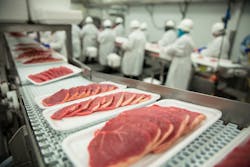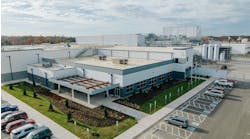As the world’s population continues to grow, the demand for food follows. Food and beverage processors have little choice than to innovate to meet that future demand. Yet, the path can wind and branch in many directions. Depending on the food segment, specific expectations vary as to what the food plant of the future might feature.
Overall, however, a few topics float to the surface no matter the segment of food & beverage processing. Automation stands tall for its ability to reduce the number of workers needed while increasing production capacity and minimizing waste, and some food segments have traveled quite far along this path.
Still, the food plant of the future will need to be even more flexible to allow for more changeovers, no matter what products it produces, says Jeff Jendryk, senior director of business development at Kiewit Industrial Group.
Improvements in robotics, vision systems and sensors linked to refined artificial intelligence (AI) and machine learning algorithms will allow for more complex tasks to be automated, explains Angel Landeros, capital project manager for Hixson Architecture, Engineering & Process.
“Creating highly automated and customizable process and packing systems could create an opportunity for hyperlocal, highly adaptable supply chains that can meet local consumer needs from one day to another,” he adds.
AI, vision systems help meat catch up
For decades, many segments of the food & beverage industry typically have outrun the meat and poultry processing industry in the race to automate processes, but technology finally has evolved to better handle the variability of the animals harvested.
Casey Gallimore, director of regulatory policy for the North American Meat Institute, says the plant of the future in poultry and pork may already be here. Furthermore, she sees machine learning and AI driving automation in beef plants as it has done for poultry and pork over the years. “We haven't seen the same adoption rate in beef plants, but I think that's something we'll see change,” she says.
A similar assessment of what to expect in the beef industry is given by Mark Gwin, product integration manager for Certified Angus Beef. “I think we can absolutely expect to see automated harvesting and processing become an industry-wide phenomenon by the year 2030,” he says. “AI on the lines will be able to adapt to different carcasses, and in turn will allow for increased efficiency and consistency.”
“Vision systems have come a long way within the past 10 years,” she adds. “We see vision systems used for foreign material detection and other tasks, including collecting quality information on the process.”
Advanced sensors and data collection devices allow machines to optimize all types of processes, from sorting and grading to cooking and packaging.
“We’re going to see more data-driven, interconnected systems that are intuitive and responding in real-time,” Gallimore adds. “Maybe we see a machine’s cut is drifting off by a quarter of an inch — we can be more responsive to adjust that in real time now rather than waiting until somebody finds out during a quality audit two hours later.”
Even with all this innovation leading to fewer workers on the plant floor, Landeros offers a reminder that food processors cannot just shut the doors and let the machines run without some sort of human intervention.
“There will need to be a skilled and trained workforce to maintain, upgrade and troubleshoot automated systems and their programs,” he says. The key is, those workers will have safer, better quality jobs. Gallimore believes there will be a wave of skills needed in processing plants unlike any type of skillset needed before.
“The type of workforce we have will need to change, and we've already started to see that shift toward more maintenance personnel or more IT personnel to analyze all the data,” she says. “There will be a great opportunity to take our existing workforce, use their talents and help them develop the additional skills needed to fill those future jobs.”
For the meat and poultry plant of the future, however, Gallimore says there won’t be many empty rooms, and worker safety efforts must evolve because of that.
“In chocolate or cereal ingredients, for example, you have people operating the machines processing those products,” she says, “In meat and poultry, you're dealing with a live animal, so there are so many nuances and differences. I would be shocked if meat and poultry ever reached the level of automation of some other food segments.”
Thus, NAMI’s Protein PACT — a collective vision and set of goals for the future of the meat industry — includes a worker safety goal by which members will reduce workplace injuries by 50% (from the 2019 baseline), building off reductions the industry made the prior 20 years.
Supercharging sustainability
The need for more sustainable operations reaches across all food segments. Sustainability shall be prioritized in the food plant of the future through a variety of initiatives and technological innovations.
Landeros believes energy efficiency and alternate energy sources will play a bigger role in future plant site design, pushed in that direction by regulations curbing fossil fuel use and the fragility of large power grids. Food & beverage plants that need 24/7 temperature control will feel the pressure if they do not proactively adjust.
“Energy and water scarcity will continue to grow, and the cost and management of both will become a larger factor when assessing the viability of a new site or process,” he explains. “Energy and water resiliency also might limit capital investment, scope and location for food manufacturing facilities.”
Jendryk believes skyrocketing energy costs will drive food plants to consider alternatives for facility power, but also for fleets serving the plant.
“Energy costs are literally going through the roof, and solar panels are being used to create a more sustainable facility,” he says. “If plants have charging stations for electric semi-trucks, where the cab can be charged up for its next route while the trailer is being loaded or unloaded, that will require site and facility modifications for the plant of the future.”
Recycling and the evolution of recyclable plastics have been a focus for many processors for years, and several have signed on to various pacts and partnerships to set and achieve specific goals. Landeros believes the pressure will only increase, with single-use plastic bans and global legislation expanding to force manufacturers to find alternatives to plastic packaging. In turn, potential renovations to plants and packaging lines may follow.
“New sustainable packing materials and designs will require retrofitting existing lines or whole new packing lines to meet new regulations,” he says. “However, from disruption can come innovation.”
Such advances might include new packing and process designs, circular supply chains that bring containers back to the site for reuse and/or complete changes in consumer preference and behavior.
“All of these changes would create a growth opportunity for companies agile enough to adapt quickly,” Landeros says.
The challenge with converting to 100% recyclable packaging, Gallimore contends, is that the infrastructure to ensure the material actually gets recycled isn’t foolproof. To that end, the Massachusetts Institute of Technology (MIT) announced in February that it was working with five mega CPG companies to redevelop the recycled material sorting process so the small plastic containers (think, those that hold cosmetics or travel-size personal care items, for example) do not slip through the cracks and end up in the waste stream.
Gallimore explains the approach of the meat industry as trying to do more with less. She believes the meat and poultry industry’s focus on reduction and reuse of water has been a great focal point that has produced measurable success, and she expects innovation to continue in that arena.
“We will try and recapture resources and recycle resources where we can, and I think there will be some really creative adaptations in the next five to 10 years on how to reuse water and make that technology more accessible to individual plants,” she predicts. “I think the industry is working toward plants being self-sufficient, relying less on outside resources.”
With the growing population needing more food, Gallimore says, the industry needs to ensure product is available to all consumers at affordable prices — and that it was produced and processed responsibly so that consumers want to purchase and support them.
It’s a statement to which almost any food processor can relate and aspire to provide. How can the food plant of the future produce more food at the same level of quality and safety with fewer resources and a smaller physical and environmental footprint?
Like many in and around the industry, Gwin marvels at how far the beef industry has advanced technologically, but his sentiments really ring true for much of the food & beverage industry.
“If you would have told me about these new technologies when I first started my career, I’m not sure I would have believed you,” he says. “So, it’s really exciting to see how far the industry has come and how we’ve challenged ourselves to be innovative.”
In a decade or two, the food plant of the future likely will feature invention, technology and maybe even some surprises that excite even more — and ultimately feeds a bigger world of people.




